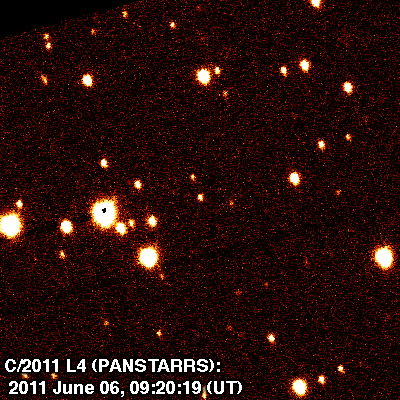[/caption]
Pan-STARRS… Doesn’t that conjure up an image of a faceless stranger whispering in the dark, passing their hand over a clear sky and leaving a glittering trail? Pan-STARRS… Take the second star on the left and go straight on ’til morning. Pan-STARRS… Regardless of my flights of fancy, Pan-STARRS is a telescopic reality and its home is Mount Haleakala, Hawaii. The Panoramic Survey Telescope and Rapid Response System is renowned for its wide-field imaging capabilities – and its mission to alert planet Earth of potentially dangerous objects approaching. Now the most recent discovery is a comet which may be visible to the naked eye in early 2013.
Discovered on the night of June 5-6 using the Pan-STARRS 1 telescope, the moving rogue was confirmed to be a comet on the following night by astronomer Richard Wainscoat and graduate student Marco Micheli using the Canada-France-Hawaii Telescope on Mauna Kea. The Oort Cloud visitor quickly had its orbit calculated by the Harvard Minor Planet Center and shows it will be visiting in our solar system within about 30 million miles (50 million km) of the Sun in early 2013. While that’s about the same distance as the Sol / Mercury factor, the comet will not encounter Earth… just give us a good show.
Wainscoat said, “The comet has an orbit that is close to parabolic, meaning that this may be the first time it will ever come close to the sun, and that it may never return.” Just like our stranger in the dark, eh?
Will this new comet named C/2011 L4 (PANSTARRS) create a spectacle? It’s not easy to judge. While it is expected to be brightest in February or March 2013, it depends on how much ice it contains as to how bright it will become. Another factor is positioning. Since it will be low to the west at sunset, sky brightness may also make it difficult to observe. Right now C/2011 L4 is about 700 million miles (1.2 billion km) from the Sun, placing it beyond the orbit of Jupiter and only able to be spotted using a large telescope and imaging equipment. It will take several months of observation for more accurate assessments, but astronomers are cautious since many predictions can end up being a cometary dud. There’s no doubt it will be here – but there’s always uncertainties as to how bright it will be.
In the mean time, we’ll take Pan-STARRS whispering word for it… and believe.
Original Story Source: Institute for Astronomy / University of Hawaii.


Yeah, I’m old enough to remember(!) Comet Kohoutek!